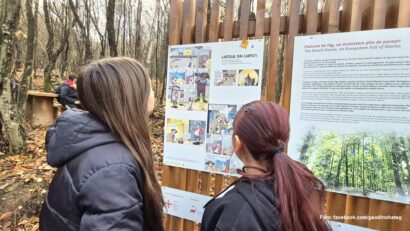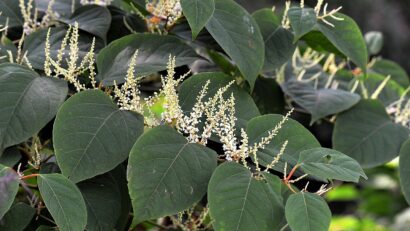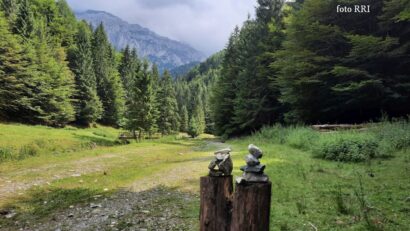Romania’s Virgin Forests
230 million hectares of forested land will be wiped out by 2050, if preventive measures are not taken. This warning comes from the latest study compiled by the World Wide Fund for Nature.

Eugen Cojocariu, 29.04.2012, 17:24
230 million hectares of forested land will be wiped out by 2050, if preventive measures are not taken. This warning comes from the latest study compiled by the World Wide Fund for Nature.
Ancient beech forests have already suffered greatly from deforestation. Poor administration in the past few decades has led to the complete disappearance of ancient forests in developed countries, while animal and plant habitats have been strongly affected by human activity.
The cost has been immense, as these virgin forests — also known as ‘old growth forests’’ – are a vital source of fresh water, they absorb carbon dioxide, and also stabilize the soil and climate. Moreover, ancient forests in Romania are home to Europe’s prized large carnivores — the brown bear, the wolf and the lynx.
Ancient, or ‘’virgin’’ forests, cover 0.3 percent of the total area of the Danube-Carpathians eco-region. This amounts to 322 thousand forested hectares, most of which are on Romanian territory. The World Wide Fund has recently launched a campaign entitled “Save the virgin forests”, meant to gain legal protection for Romania’s old-growth forests.
The Fund also warned that 80 percent of these forests are not currently protected by law and many risk being destroyed. One development project aims to build ski-ing facilities in the Ceahlau National Park, while small hydroelectric plants are being built on rivers and creeks throughout the Carpathian chain.
Additionally, building national roads through forested land could destroy animal habitats. Green organizations are condemning these projects, which they say are damaging biodiversity. Here is Gabriel Paun, head of the Agent Green organization.
Gabriel Paun: “Beautiful countries like Austria, Switzerland or France are no longer home to virgin forests and untouched natural scenery. They have been destroyed by human development. It’s too late now to save anything. For example, when Austria was planning to build national parks, they realized they didn’t have much space for it. At present, national parks only cover 2.8 percent of Austria’s territory, and we’re not talking about virgin forests here. At the other end of the spectrum, we have Romania, with the most virgin forests in all of Europe. A study conducted a few years ago by the Institute for Forestry Research and a Dutch institute charted Romania’s virgin forests, finding over 218,000 hectares of old-growth forests in groups of at least 5 hectares each.”
The Retezat National park is home to 5 thousand hectares of wild forests, the biggest such area in all of Europe. In 2009, the park received an award from the European Council in recognition of its stunning scenery, rich flora and fauna, as well as vast old-growth forests. It is here that ecologists have recently discovered the last Intact Forest Landscape in temperate Europe. The only other areas with unbroken expanses of natural forest ecosystems are northern Canada and Russia, and the tropical forests of the Amazon and Congo. Gabriel Paun again at the microphone:
Gabriel Paun: “Recently, this area was the target of barbaric attacks, when a large number of trees in the Rau Ses Valley were cut down, allegedly having been blighted by insects. Far too many trees were cut down and that particular forested area was compromised. It lost part of its untouched landscape. Fortunately, the media was called by environmental protection agencies and a decision was made to increase the area’s level of legal protection. This is a victory we earned one step at a time, but much more is needed to effectively keep that area untouched.”
The Green Agent Organization has recently started an alternative project to preserve biodiversity in this region by getting local communities involved in ecotourism.
Gabriel Paun: “In order to secure long-term protection, we’ve decided to work together with local communities by getting them involved in an alternative regional development program through ecotourism. The film “Wild Carpathia” was recently released, with support from HRH Prince Charles. We’ve began bringing in tourists from the UK and other west-European countries right here in Retezat. All the money they spend on accommodation, on local tour guides, on traditional meals and transport will go to the communities, in order to encourage them to keep their natural heritage intact. Tourists come here to see what their homeland has lost.”
In less than three weeks after the campaign was launched, 72 thousand signatures were gathered to change the legislation on old-growth forests. Environment minister Laszlo Borbely has said that the bill meant to protect these natural treasures will be finalized by the end of the year.
Meanwhile, a protocol of collaboration with the world Wide Fund will be finalized in a few weeks, in order to better protect Romania’s virgin forests. Borbely also announced that the Environment Ministry, together with the Agriculture and Rural Development Ministry, has identified European funds worth 100 million euros, to be used to compensate private owners of virgin forest lands.






























